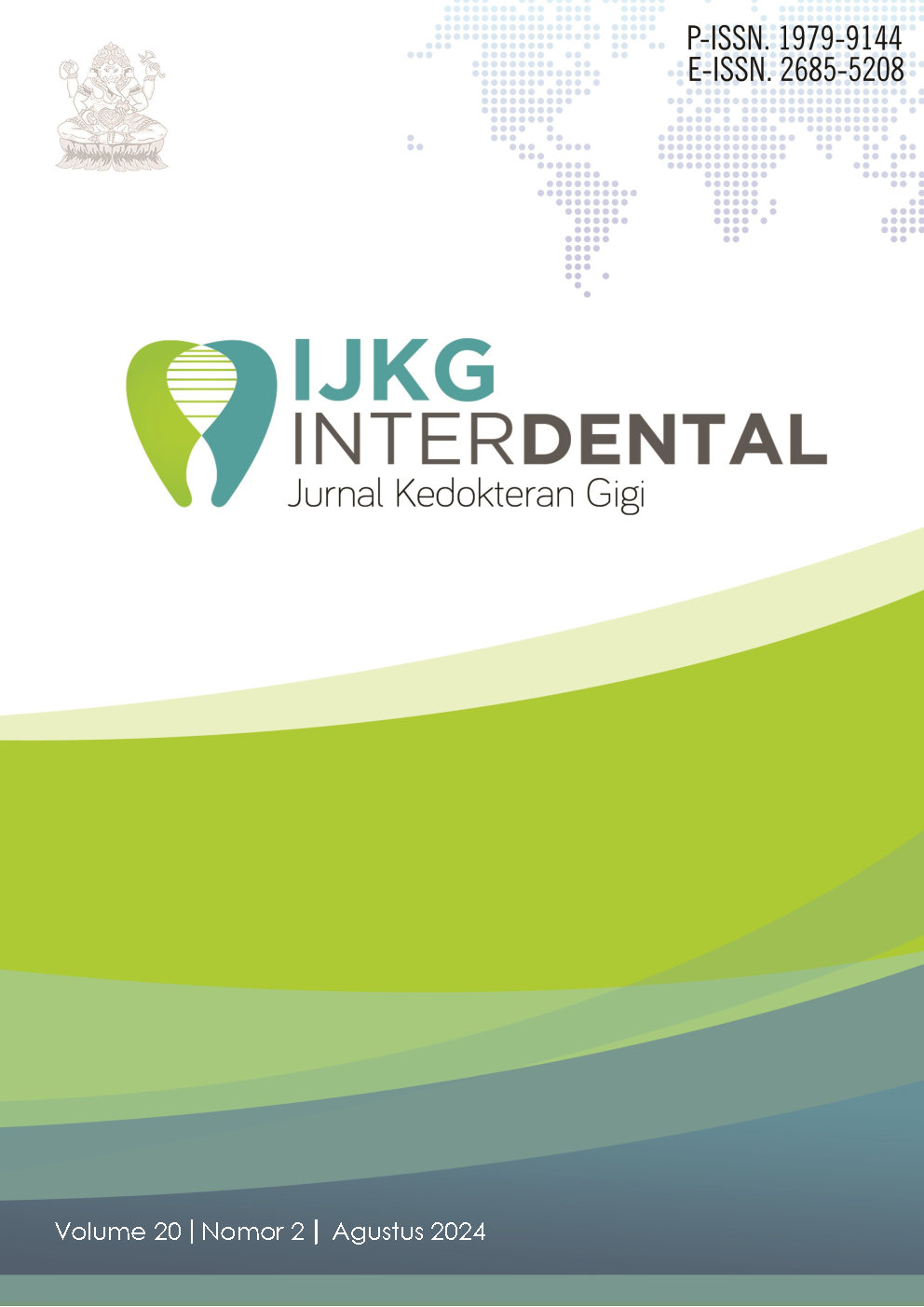Effects of Chitosan Membrane on Osteogenesis and Oral Wound Healing: A Literature Review
DOI:
https://doi.org/10.46862/interdental.v20i2.8632Keywords:
Chitosan membrane , osteogenesis , oral wound healingAbstract
Introduction: Chitosan is a compound produced from processed shrimp shell waste that has an important role in the medical industry. Chitosan is a straight-chain amino polysaccharide compound consisting of glucosamine monomers (poly-1,4-D- glucosamine) linked through (1-4) β-glycosidic bonds, derived from deacetylated chitin. In dentistry, chitosan plays an important role in wound healing and bone formation (osteogenesis).
Review: This literature aims to further explain the effectiveness of chitosan membranes in bone formation and wound healing in the oral cavity. Osteoblasts are new bone-forming cells, including the process of breaking down old bone and replacing it with new, healthier bone. Chitosan membranes can reduce osteoclast activity and prevent further bone resorption. Chitosan membrane plays a role in reducing the production of prostaglandin E2 and inflammatory cytokines namely Interleukin-1, Interleukin-6, and Tumor Necrosis Factor-α which play a role in the differentiation and activation of osteoclast cells directly through the activator of kβ ligand receptors. The wound healing process is dynamic and complex through systematic steps such as hemostatic, inflammatory, proliferative, and regenerative phases. Many studies have shown that chitosan membranes can accelerate wound healing by increasing the productivity of inflammatory cells.
Conclusion: Chitosan membrane is very effective in promoting osteoclastogenesis, because it can stimulate macrophage cells to reduce the production of prostaglandin E2 (PGE2) mediators, resulting in osteoclast cellular activity can be inhibited and osteoblast formation can be increased. Chitosan membrane plays an important role in accelerating wound healing by increasing the production of inflammatory mediators such as macrophages, fibroblasts, polymorphonuclear leukocytes (PMN), and osteoblasts.
Downloads
References
Maulana M. Analisis kelayakan usaha budidaya udang vaname (Litopenaeus vannamei) sistem intensif (Studi Kasus: usaha tambak Pak Boy Kabupaten Aceh Tamiang). Jurnal Penelitian Agrisamudra 2022;9(1):17-25.
Hartono BT, Firdaus FG. Pemanfaatan Biomaterial Kitosan dalam Bidang Bedah Mulut. B- Dent: Jurnal Kedokteran Gigi Universitas Baiturrahmah 2019;6(1):63-70.
Putra R. Pengaruh pemberian gel chitosan terhadap penyembuhan luka incisi pada tikus putih (Rattus norvegicus). Jurnal Ilmiah Mahasiswa Veteriner 2018;2(4):442-449. Doi: https://doi.org/10.21157/jim%20vet..v2i4.8733
Chaesaria G, Hasan M. Pengaruh kitosan cangkang udang putih (Penaeus merguiensis) terhadap jumlah sel osteoblas tulang femur tikus wistar betina pasca ovariektomi. E-Jurnal Pustaka Kesehatan 2015;3(3):375-379.
Nur M. Pengaruh Kitosan terhadap jumlah osteoklas dan osteoblas pada tikus galur wistar model menopause. Journal of Islamic Medicine 2017;1(2):76-87. Doi: https://doi.org/10.18860/jim.v1i2.4456
Perchyonok VT, Reher V, Zhang S, Basson N, Grobler S. Evaluation of nystatin containing chitosan hydrogels as potential dual action bio-active restorative materials: in vitro approach. Journal of Functional Biomaterials.2014;5(4):259-272. Doi: https://doi.org/10.3390/jfb5040259
Wedagama DM. Buku Ajar: Nano chitosan mempercepat regenerasi tulang alveolar pasca apekreseksi melalui sel osteoblas, sel osteoklas, mast cell dan growth factor. Universitas Mahasaraswati Denpasar: Unmas Press; 2018.
De Jesus GJP. The effects of chitosan on the healing process of the oral mucosa: An observational cohort feasibility split-mouth study, Nanomaterial (Basel) 2018;13(4):706.
Doi: https://doi.org/10.3390/nano13040706
Dreifke MB, Jayasuriya AA, Jayasuriya AC. Current wound healing procedures and potential care, Mater Sci Eng C Mater Biol Appl. 2015;48: 651-662. Doi: https://doi.org/10.1016%2Fj.msec.2014.12.068
Fujimura T, Mitani A, Fukuda M. Irradiation with a low-level diode laser induces the developmental endothelial locus-1 gene and reduces proinflammatory cytokines in epithelial cells, Laser in Medical Science 2014;29(3): 987-994, Doi: https://doi.org/10.1007/s10103-013-1439-6
Hernowo BS, Sabirin IPR, Maskoen AM. Peran ekstrak etanol topikal daun mengkudu (Morinda citrifolia L.) pada penyembuhan luka ditinjau dari imunoekspresi CD34 dan kolagen pada tikus galur wistar, Majalah Kedokteran Bandung. 2013;45(4):226-233. Doi: http://dx.doi.org/10.15395/mkb.v45n4.169
Perchyonok VT, Grobler SR, Zhang S. IPNs from cyclodextrin: chitosan antioxidants: bonding, bio- adhesion, antioxidant capacity and drug release. Journal of Functional Biomaterials. 2014;5(3):183-196. Doi: https://doi.org/10.3390%2Fjfb5030183
Saragih RAC. Perbandingan histopatologis kolagen parut akne dengan terapi kombinasi microneeding dan subsisi antara yang disertai platelet rich plasma dengan disertai larutan saline fisiologis. Tesis. Medan: Fakultas Kedokteran Universitas Sumatera Utara; 2013.
Downloads
Published
How to Cite
Issue
Section
License
Copyright (c) 2024 Ni Putu Dian Cipta Dewi, Ni Putu Sulistiawati Dewi

This work is licensed under a Creative Commons Attribution-ShareAlike 4.0 International License.
- Every manuscript submitted to must observe the policy and terms set by the Interdental Jurnal Kedokteran Gigi (IJKG)
- Publication rights to manuscript content published by the Interdental Jurnal Kedokteran Gigi (IJKG) is owned by the journal with the consent and approval of the author(s) concerned.
- Full texts of electronically published manuscripts can be accessed free of charge and used according to the license shown below.













